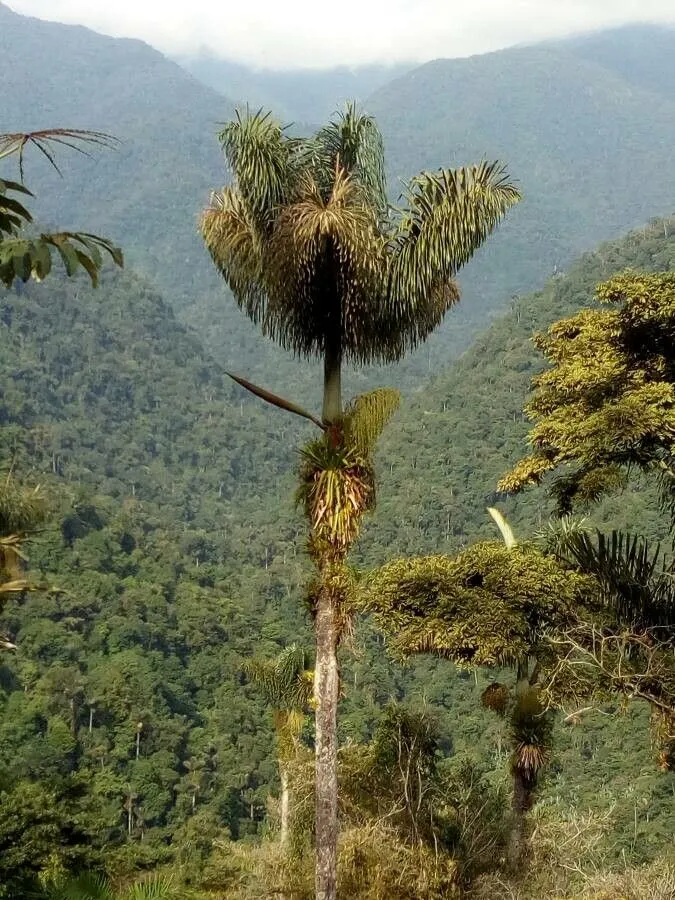
Author: Ruiz & Pav.
Bibliography: Syst. Veg. Fl. Peruv. Chil.: 301 (1798)
Year: 1798
Status: accepted
Rank: species
Genus: Phytelephas
Vegetable: False
Observations: Panama to Bolivia and NW. Brazil
The Ivory palm, scientifically known as Phytelephas macrocarpa, is a remarkable and unique member of the Arecaceae family. Native to the lush, diverse regions stretching from Panama through Bolivia, and reaching into northwestern Brazil, this palm tree has fascinated botanists and plant enthusiasts for centuries. Its formal classification and description were first documented in 1798 by the renowned botanists Ruiz and Pavon in their seminal work, “Systema Vegetabilium Florae Peruvianae et Chilensis”.
The Ivory palm derives its name from its seeds, which produce a dense, white material colloquially known as “vegetable ivory” or “tagua”. This distinct and eco-friendly substance has become a sustainable alternative to animal ivory, cherished for its similar texture and appearance. The nuts from this palm are harvested without harming the tree, making it an excellent resource for artisans and craftsmen who create buttons, jewelry, and other ornamental items.
Growing predominantly in tropical rainforests, the Ivory palm thrives in humid environments with ample rainfall. It features a striking appearance with tall, slender trunks reaching up to 20 meters crowned by a canopy of large, feather-like fronds. Underneath the canopy, clumps of dense, fibrous roots help stabilize the tree and absorb nutrients from the rich, loamy soils of its native habitats.
One of the most fascinating aspects of the Ivory palm is its reproductive strategy. Unlike many other palm species, the Ivory palm is dioecious, meaning individual trees are either male or female. The male trees produce clusters of small, inconspicuous flowers, while the female trees bear large, woody fruits containing the valuable tagua nuts. These fruits are highly sought after both by local wildlife and by humans for their economic value.
Beyond its unique physical properties, the Ivory palm plays a crucial ecological role. It provides essential habitats and food resources for a variety of rainforest species, including birds, insects, and rodents. The tree’s presence in the ecosystem supports biodiversity and helps sustain the delicate balance of tropical forest environments.
The exploitation of Ivory palm nuts for commercial purposes has raised important conservation concerns. Efforts are underway to ensure that harvesting practices are sustainable and that local communities benefit from the trade in vegetable ivory. These initiatives aim to balance economic development with the preservation of natural habitats, ensuring that the Ivory palm can continue to thrive and support biodiversity across its native range.
Overall, Phytelephas macrocarpa stands as a symbol of nature’s ingenuity, offering a renewable resource that aligns economic interests with environmental stewardship. Its enduring legacy, as captured by Ruiz and Pavon over two centuries ago, underscores the importance of this remarkable palm within both ecological and human realms.
Deu: elfenbeinpalme, steinnußpalme
Swe: elfenbenspalm
Spa: homero, marfil vegetal, palma de marfil
Fra: ivoire végétal
Eng: ivory nut palm, ivory palm, ivory-nut palm, tagua palm
Por: jarina, marfim-vegetal
En: Ivory palm, Ivory-nut palm, Tagua palm, Ivory nut palm
Fr: Ivoire végétal
De: Steinnußpalme, Elfenbeinpalme
Pt: Jarina, Marfim-vegetal
Es: Palma de marfil, Marfil vegetal, Homero, Yarina, Tagua
Sv: Elfenbenspalm
Taken Jan 4, 2022 by Maarten Vanhove (cc-by-sa)
Taken Mar 20, 2022 by Bernd Lehmann (cc-by-sa)
Taken Jan 4, 2022 by Maarten Vanhove (cc-by-sa)
Taken Jan 4, 2022 by Maarten Vanhove (cc-by-sa)
Taken Mar 20, 2022 by Bernd Lehmann (cc-by-sa)
Taken Mar 20, 2022 by Bernd Lehmann (cc-by-sa)
© copyright of the Board of Trustees of the Royal Botanic Gardens, Kew.
© copyright of the Board of Trustees of the Royal Botanic Gardens, Kew.
© copyright of the Board of Trustees of the Royal Botanic Gardens, Kew.
Family: Myrtaceae Author: (F.Muell.) K.D.Hill & L.A.S.Johnson Bibliography: Telopea 6: 402 (1995) Year: 1995 Status:…
Family: Rubiaceae Author: Pierre ex A.Froehner Bibliography: Notizbl. Bot. Gart. Berlin-Dahlem 1: 237 (1897) Year:…
Family: Sapindaceae Author: Koidz. Bibliography: J. Coll. Sci. Imp. Univ. Tokyo 32(1): 38 (1911) Year:…
Family: Asteraceae Author: A.Gray Bibliography: Pacif. Railr. Rep.: 107 (1857) Year: 1857 Status: accepted Rank:…
Family: Fabaceae Author: Medik. Bibliography: Vorles. Churpfälz. Phys.-Ökon. Ges. 2: 398 (1787) Year: 1787 Status:…
Family: Aspleniaceae Author: (Cav.) Alston Bibliography: Bull. Misc. Inform. Kew 1932: 309 (1932) Year: 1932…